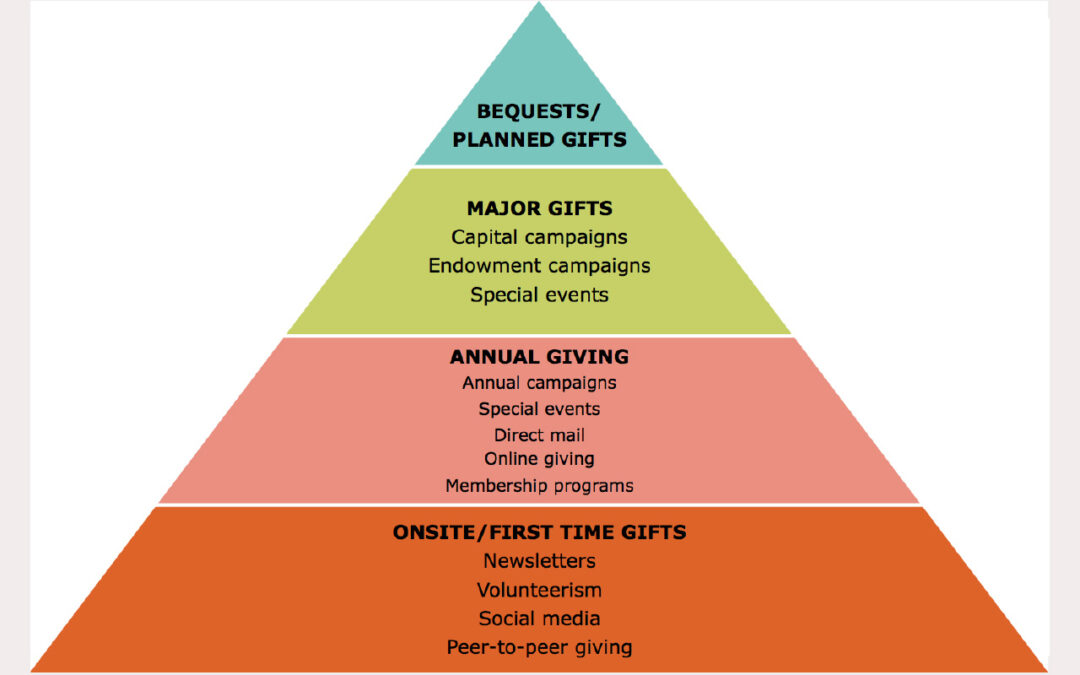Effective donor stewardship is key to gaining long-term support for your nonprofit organization. When new donors give only once, nonprofits experience a loss on the initial investment acquiring them. We’ve previously discussed strategies that your organization can use to build relationships with donors to receive repeat donations. It starts with implementing a strong donor stewardship plan, which maps the process for thanking your donors with the goal of building lasting relationships. It involves updating donors on the progress and impact of their gifts and continuing the donor cultivation cycle.
The key is remembering there is no one-size-fits-all approach. Nonprofits often manage donors at varying levels of giving capacities, resulting in different stewardship strategies per donor group. A donor pyramid is a visual tool that represents a donor base by giving level, with lead donors and planned giving such as bequests at the top, followed by major donors, mid-level donors and lower-level donors.
While criticized by some as outdated and flawed, at The Dennis Group we see tremendous value in this tried, tested and true fundraising tool used in capturing the nuances of modern philanthropy, proponents of the donor pyramid argue that it remains a tool for measuring progress and planning fundraising goals. It’s one of many tools for fundraisers where the mid-level segment can emerge as a crucial focal point for upward growth.
Steady Support and Advocacy
Mid-level donors may give monthly or quarterly, or they might make one annual donation. They provide steady and reliable funding and typically have the potential to increase their giving over time when cultivated correctly. Typically, when donors achieve mid-levels of giving, their personal connection and affinity has evolved and grown with the nonprofit organization and are therefore more likely to advocate for the cause within their communities.
Careful attention to stewarding these donors can result in much larger, transformational gifts at the leadership level, in time. Whether it’s $1,000, $5,000 or $10,000, the gift size that qualifies as mid-level should align with your nonprofit’s mission, goals and average donation sizes. Stewarding your donor by personal notes (for example, from the Executive Director, close staff member, client, patient or relevant constituent), a call, or, for higher level donors, an invitation to meet, shows your appreciation, sending the message that you value their contributions and that they are making a difference in your organization. This can go a long way towards building loyalty and ensuring that they continue to support your organization in the future.
Tailoring Connections for Mid-Level Donors
-
- Segment your mid-level donors based on giving history, personal interests or engagement level.
- Customize your messaging to cater to each group’s preferences.
- Invite them to learn your strategic plans and priorities through in-person meetings or phone calls, emphasizing the impact of their previous contributions and connecting them to your organization’s larger goals.
- Highlight specific projects aligned with their interests.
- Illustrate the tangible benefits of increased giving, explaining how their support can amplify the difference your organization makes in the communities you serve.
Although the donor pyramid draws attention to top donors, its shape emphasizes the importance of maintaining a strong base. Fundraisers can work with this and ask questions like: Where are our largest number of donors? Is that aligned with our organizational goals? How has this evolved, and do we have the right team in the right places?
It is essential to recognize that success goes beyond metrics. Building relationships is the ultimate goal, achieved through meaningful conversations that uncover donors’ values and interests. Fundraisers must go beyond statistical analysis and provide inspiration, strengthening a connection that transcends the pyramid and motivates donors to contribute passionately to your cause.
The Dennis Group Inc. can help your organization create strategies to achieve success in all areas of non-profit management, including research, campaign and fund development expertise, organizational development and planning, communications and stewardship. Contact us to learn more.

Recent Comments